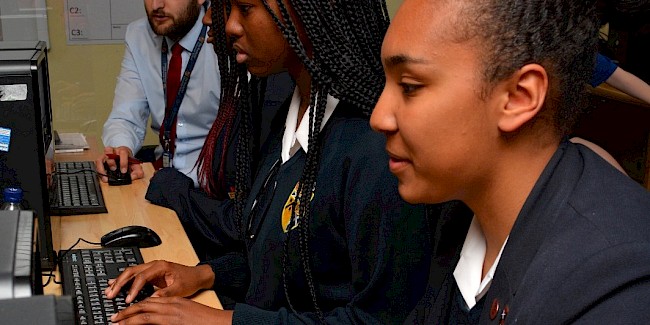Key Stage 4 OCR Creative iMedia
Curriculum Overview
Students follow the OCR Creative iMedia course. This course is an option at Key Stage 4
| | Term 1 | Term 2 | Term 3 | Term 4 | Term 5 | Term 6 |
|---|
| Year 10 | R094 – Visual identity and digital graphics | R094 – Visual identity and digital graphics | R094 – Visual identity and digital graphics & R093 – Creative iMedia in the media industry | R093 – Creative iMedia in the media industry | R093 – Creative iMedia in the media industry | R093 – Creative iMedia in the media industry |
| Year 11 | R098 – Visual imaging | R098 – Visual imaging | R098 – Visual imaging | Revision | Revision | |
Year 10
Students will begin the Creative iMedia course exploring the digital graphics unit. They will explore the theory behind visual identity and design principles for creating an effective graphic, and will then put this into practice by applying this through creating digital graphics using Adobe Photoshop. This will the culminate with students completing their non-examined assessment on this unit. Once completed, students will then be exploring a wide range of topics related to Creative iMedia in the media industry.
Year 11
Students will begin the final year of the course looking at visual imaging principles and how to use visual imaging equipment and software effectively to create a suitable portfolio for a client. This will then lead towards their second piece of non-examined assessment. Students will then begin making the final preparations for their written examination, which will incorporate the theory taught during all three units.
Assessment of Creative iMedia
- R081: Pre-production documents. 1 hour 15 min written exam. Worth 25%.
- R082: Creating a digital graphic. Coursework assignment. 30 guided learning hours (10 of which are formally assessed). Worth 25%
- R085: Creating a multipage website. Coursework assignment. 30 guided learning hours (10 of which are formally assessed). Worth 25%
- R090: Digital photography. Coursework assignment. 30 guided learning hours (10 of which are formally assessed). Worth 25%
Further Reading/Resources
Key Stage 4 Computer Science
Curriculum Overview
Students at Key Stage 4 have two periods a week studying the OCR GCSE Computer Science qualification.
| | Term 1 | Term 2 | Term 3 | Term 4 | Term 5 | Term 6 |
|---|
| Year 10 | The CPU, Memory and Storage | The Internet | Networks | Ethical, moral and cultural issues | Algorithms | Programming concepts |
| Year 11 | Programming skills | Programming Project | Data representation | Revision | Revision | |
Year 10
Students explore the theory components that contribute to their Paper 1 examination, to be sat at the end of the second year of their programme of study. They will study five components that are wide-ranging in nature, and will have opportunities to develop the foundations needed to become a successful Computer Scientist.
Students will also begin developing basic programming skills in readiness for the completion of their mandatory programming project in their second year of study. The skills they will be learning here are also transferrable to their Paper 2 examination.
Year 11
Students will continue to build upon their programming skills at the start of the year, in preparation for their mandatory project. This project will take place during the first-half of this year.
Students will then explore the theory components that contribute to their Paper 2 examination, to be sat at the end of the second year of their programme of study. They will be studying topics including algorithms and data representation.
Assessment at GCSE
- Paper 1: 50% of qualification. Written examination. 1 hour 30 minutes. Completed at the end of their second year of study.
- Paper 2: 50% of qualification. Written examination. 1 hour 30 minutes. Completed at the end of their second year of study.
- Programming project. Mandatory unit in order to be able to certificate at the end of the course.
Further Reading/Resources



